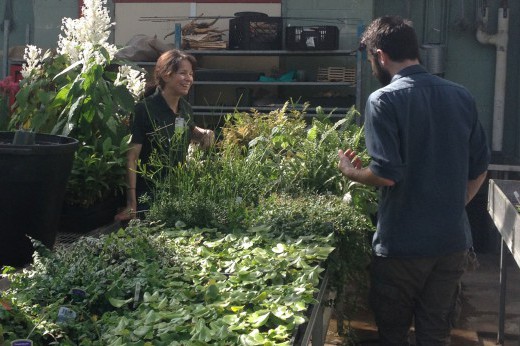As populations grow in cities around the world, urban agriculture is finding all kinds of niches. In Singapore, young people with autism grow food indoors as part of a job-training program focused on edible gardens. In Tokyo, urban farmers play a role in disaster preparedness by ensuring access to local food and providing space for evacuation. In Seoul, urban beekeepers tend rooftop hives all over town, including atop the UNESCO building.
Earlier this year, I learned more about these projects and other advances in urban agriculture internationally at the 5th Seoul Urban Agriculture Expo International Conference. At Brooklyn Botanic Garden, I work with teachers and their students to bring science learning into school gardens, and I also coordinate a summer scholarship program in BBG’s Children’s Garden. When I arrived in Seoul, I was surrounded by peers from East Asia, Australia, and Europe who, like me, work in some aspect of urban farming.
Edible container and rooftop gardens for apartment buildings, hotels, and restaurants seem to be a major trend. Bjorn Low, cofounder of Edible Garden City in Singapore, was one of the many entrepreneurs at the conference who have developed businesses based on this idea. He spearheaded a job-training program for young people with autism, in which they grow food indoors with a hydroponic LED system, and he is installing gardens at day-care centers, schools, and senior centers. In Paris, Mayor Anne Hidalgo has set the ambitious goal of greening 250 acres of city roofs and walls by 2020, Parisian landscape architect Marie Dehaine explained. One third of this space must be dedicated to edible plants.
Meanwhile, in Seoul, Mayor Park Won Soon, one year after taking office, proclaimed 2012 as the “beginning of urban farming” and invested $5.7 million to convert one percent of the city into urban farms. He spoke at the expo and said that as recently as 2011, “the concept of urban agriculture was not very familiar...but now it has become a rapidly growing trend.”
A field trip acquainted me with the excellent Seoul subway system and gave me a look at the city’s recent projects, many of them edible and habitat gardens on rooftops and vacant or underutilized land. I saw an amazing rooftop garden on the UNESCO building in the middle of downtown Seoul, complete with a little stream and beehives, tended by Urban Bees Seoul. Its view revealed quite a few other green rooftops.
I also visited the Nodeul Island Community Farm in central Seoul, which has hundreds of community farm plots, much like the Floyd Bennett Gardens Association in Marine Park, Brooklyn. Most crops we saw were nonindigenous, such as potatoes, peanuts, and peppers, but about 5,000 square feet of space were set aside for the cultivation of traditional crops. There was also a vast rice field that is ceremoniously planted with the help of oxen in late spring.
I was proud to represent BBG’s Children’s Garden. Our 100-year-old program was unique among the relatively new educational farm and garden programs in other parts of the globe. On a larger scale, New York City’s community gardening movement has been going strong for over 40 years, and BBG has been supporting Brooklyn’s urban gardens since the 1990s.
This fall, six of our colleagues from Seoul Children’s Grand Park visited BBG. They were very interested in our horticultural and educational practices and toured the Discovery Garden, the Water Garden, and of course, the Children’s Garden, where they were able to observe our City Farmers class in action. It is a privilege to forge such a wonderful connection with the global community of urban gardeners, all of us working in tandem to create and maintain critical green oases in our cities around the world.



